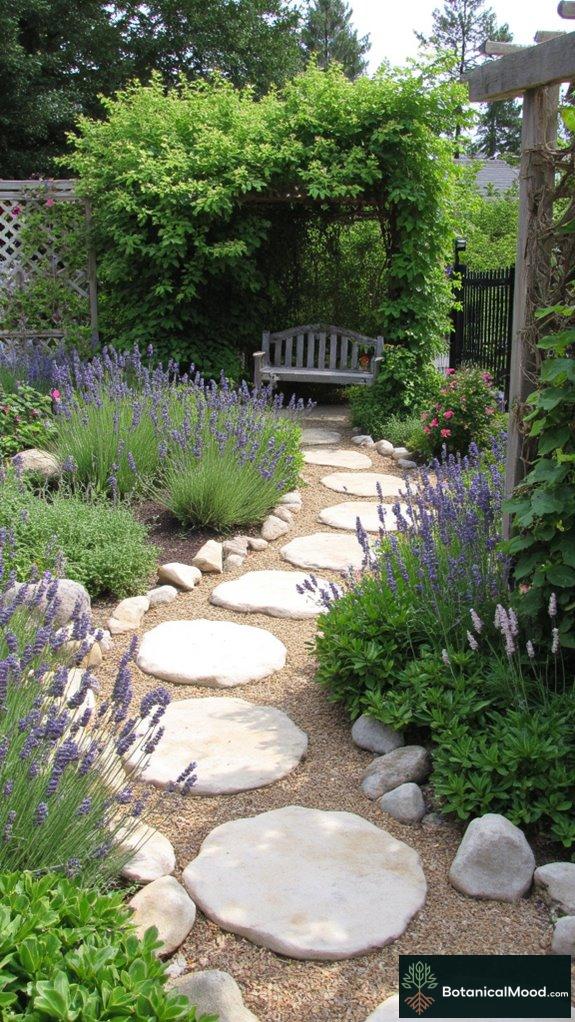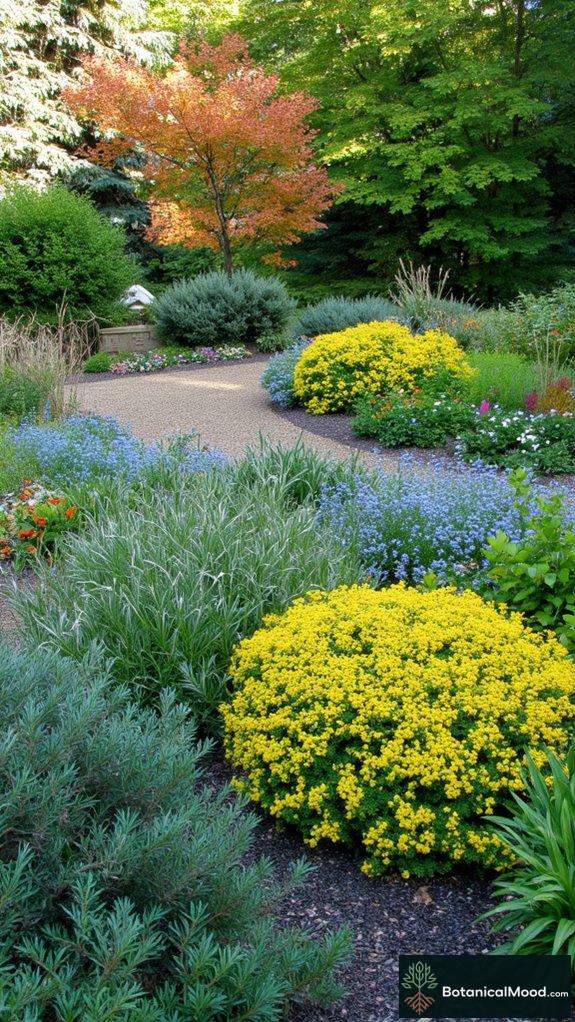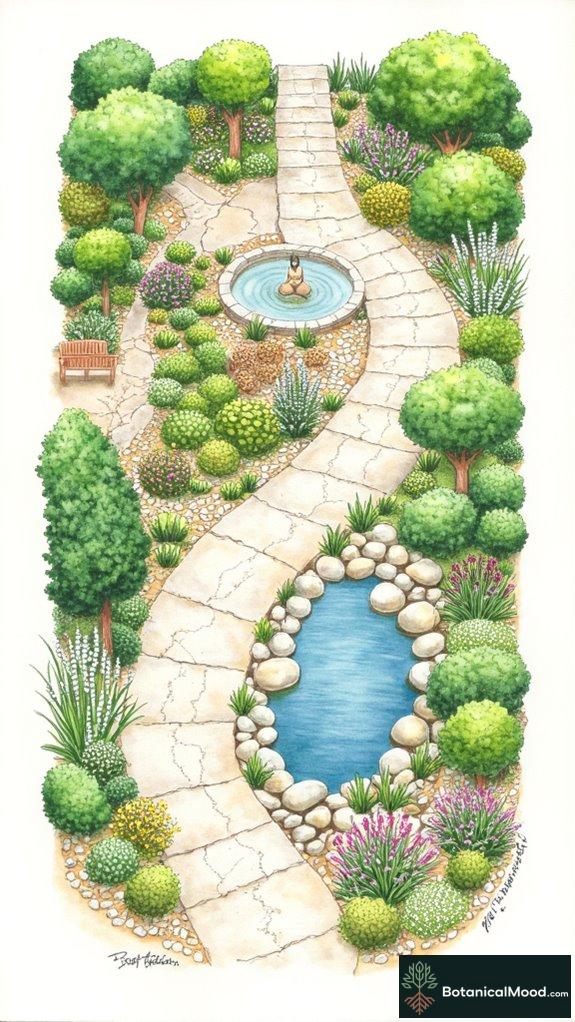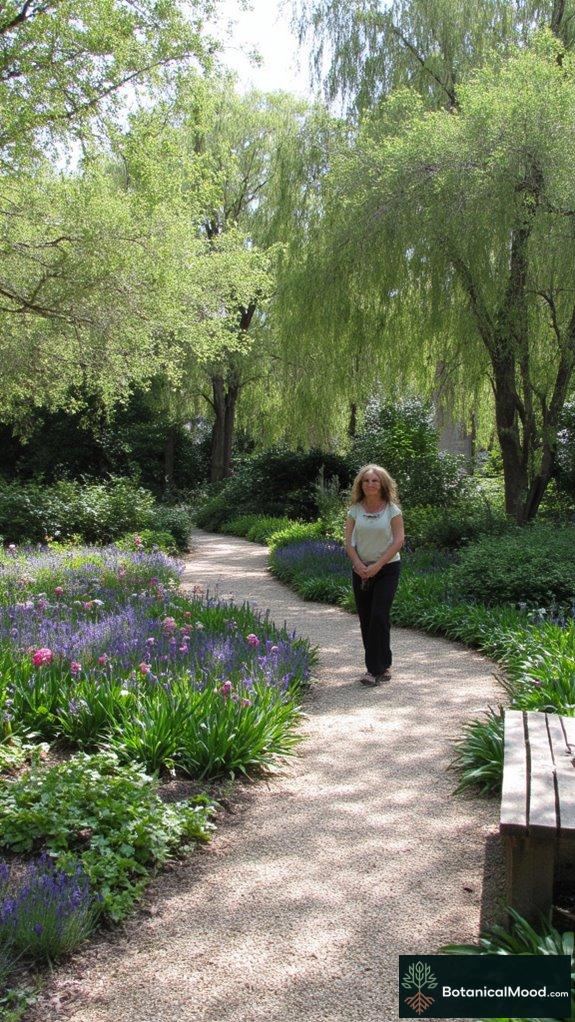Have you ever stepped into a garden and felt your stress just *poof* disappear?
That’s the magic of healing gardens.
I remember my first visit to one—overwhelmed with life, I discovered soothing lavender wafting through the air, stones that felt oddly comforting underfoot, and the gentle murmur of water that felt like a warm hug.
It’s like nature’s own therapy session, wrapped in flowers.
And let’s be honest: who doesn’t need a splash of calming blue with a hint of cheerful yellow?
Seriously, it’s an emotional oasis that invites you to just breathe.
So, why not sprinkle some joy into your own therapeutic space?
Let’s get thriving!
Designing Gardens for Emotional Healing: A Personal Reflection
To say my backyard looked like a desert wasteland before is an understatement. Trust me, my poor plants had survived an apocalypse! With a few intentional design changes—introducing vibrant sunflowers, creating texture with varied stones, and adding a water feature—I experienced a transformative shift.
My space became a sanctuary, a healing garden that echoed serenity. The buzz of bees became my soundtrack alongside a gentle breeze. It invited friends over for cozy evenings and prompted deep conversations.
Just like life’s complexities, garden design requires love and patience, but it ultimately rewards consistency with a symphony of colors and scents. The therapeutic benefits? You’ll feel them instantly!
Quick Takeaways
- Incorporate fragrant plants like lavender and chamomile to enhance emotional well-being and create immersive sensory experiences throughout the garden.
- Utilize diverse textures in plant selection to promote relaxation and encourage tactile interaction among visitors of all ages.
- Design soothing soundscapes with water features and natural sounds to promote psychological restoration and enhance the overall sensory experience.
- Implement innovative pathways and distinct zones to encourage exploration, social interaction, and individual reflection within the therapeutic garden.
- Arrange plants by height and needs while grouping in threes for visual rhythm, ensuring easy accessibility and enhancing the garden’s aesthetic appeal.
The Importance of Sensory Gardens

As I explore the world of sensory gardens, I often find myself captivated by their profound impact on individuals across various backgrounds. These therapeutic spaces offer significant emotional improvement for users, reducing agitation in dementia patients while providing essential natural distractions. Recent research has demonstrated that gardening therapy can lead to notable psychophysiological improvements among people with dementia. The design aims for inclusivity, ensuring that children, caregivers, and the elderly can all engage meaningfully, promoting multi-generational interaction.
Sensory gardens profoundly enhance emotional well-being, especially for dementia patients, offering natural distractions and meaningful connections across diverse backgrounds.
I’ve witnessed firsthand how sensory integration through diverse tactile elements, vibrant colors, and harmonious sounds fosters deep connections among users. Caregivers report heightened wellbeing as they bond with clients in these restorative environments, experiencing remarkable user engagement. Moreover, these environments incorporate multi-sensory outdoor spaces that enhance the overall therapeutic experience. It’s inspiring to see how sensory gardens transform lives, reminding me why I created Botanical Mood—to share the beauty and benefits of these incredible spaces.
Incorporating Fragrance Elements

Incorporating fragrance elements into garden design enriches the sensory experience, as these aromatic plants not only enhance the ambiance but also nurture emotional well-being.
I love exploring scent combinations like lavender and chamomile for calming spaces, while mint and rosemary invigorate the mind and spirit.
To maximize impact, I plant fragrant species along pathways, enveloping visitors in delightful aromas as they stroll.
Creating fragrance zones or “rooms” immerses individuals in a sensory journey, while trellises with climbing flowers release scents at various heights.
Fragrance layering, with strategic placement of scent-rich plants, cultivates a therapeutic environment, promoting mindfulness and emotional uplift. Additionally, integrating nectar-rich plant species helps attract butterflies and bees, creating a vibrant ecosystem that enhances overall garden health.
At Botanical Mood, I endeavor to inspire garden designs that harmonize aroma, beauty, and therapeutic benefits, taking wellness to heart.
Utilizing Textures for Touch Therapy

Textures play an essential role in the sensory experience of healing gardens, complementing fragrant elements to create a more immersive environment.
Engaging diverse textures promotes relaxation and encourages touch exploration, fostering therapeutic touch. Here are some design strategies to enhance sensory engagement:
- Material Selection: Use a blend of smooth stones and rough bark to create textural contrast.
- Textured Pathways: Incorporate interactive surfaces like crushed granite or natural slate for grounding experiences.
- Texture Layering: Combine velvety leaves with coarse grasses, inviting safe hands-on interaction.
- Tactile Arrangement: Position aromatic plants near seating areas to encourage incidental contact.
Soundscapes: Nature’s Healing Music

While the visual beauty of a garden can captivate us, it’s the soothing soundscapes of nature that often work wonders for our emotional well-being. Sound therapy plays a vital role in enhancing our experience, as gentle rustling leaves, birdsong, and flowing water promote relaxation and reduce stress.
Here’s a quick look at essential sound elements:
| Sound Element | Benefits |
|---|---|
| Water Features | Encourages meditation and calm |
| Wind Chimes | Mask urban noise, introduce harmony |
| Natural Sounds | Support psychological restoration |
Visual Aesthetics: Color and Plant Selection

Choosing the right colors and plants for a healing garden can profoundly enhance its emotional and aesthetic appeal, as the synergy between color and nature invites a sense of peace and wellness.
Effective design incorporates principles like color balance and plant diversity to cultivate an environment for healing.
- Incorporate blues and greens for tranquility, while splashes of warm yellows and oranges can energize the space.
- Select plants with varied textures to add visual complexity, inviting interaction.
- Choose seasonal bloomers, ensuring year-round color presence.
- Mix heights with shrubs and groundcovers to create rhythm and spatial distinction.
Water Features for Relaxation

When creating a healing garden, incorporating water features can transform the space into a sanctuary of relaxation and tranquility. The soothing sounds and sights of therapeutic water elements, like gentle fountains or babbling brooks, enhance relaxation and reduce stress levels.
I’ve found that even a brief exposure to running water helps lower blood pressure, promoting better mental health. These water feature benefits also include fostering peaceful reflection, as they create visually engaging spots that invite mindfulness.
Pathway Design for Mindful Exploration

Creating a healing garden involves more than just adding lovely plants and calming water features; the design of pathways plays a vital part in guiding visitors toward mindfulness and exploration.
When designing pathways, I focus on the following key elements:
- Pathway Curvature: Winding paths encourage a slower pace, promoting reflection.
- Sensory Prompts: Incorporating varied textures and aromatic plants nearby enhances sensory engagement.
- Natural Change Points: Elements like shaded arbors signal changes in space, fostering moments of pause.
- Defined Path Edges: Clear borders reduce disorientation, ensuring all visitors feel secure as they journey through the garden.
I created this website, Botanical Mood, to celebrate the profound impact that thoughtful garden design can have on our well-being, encouraging exploration and connection with nature.
Seasonal Changes for Continuous Engagement

Engaging with seasonal changes in a garden not only enhances its aesthetic appeal but also provides continuous interaction with nature, fostering a deeper connection to the environment.
By thoughtfully selecting aromatic plants like lilacs and rosemary for different seasons, or incorporating evergreens such as junipers and pines, I guarantee my garden remains vibrant year-round.
Garden maintenance becomes a creative endeavor as I layer plant heights and textures, employing species that undergo stunning color shifts.
Edible plants like strawberries in summer or hearty root vegetables in fall engage the senses.
I’ve discovered that integrating dynamic elements, like rustling grasses or water features, amplifies sensory experiences, making my garden a restorative haven, as showcased on Botanical Mood.
Sensory Pathways and Textures

The experience of walking through a garden transforms into an immersive sensory journey, where pathways serve as the guiding threads of exploration.
Walking through a garden becomes an enchanting sensory adventure, where winding paths lead to delightful discoveries.
To optimize sensory engagement and promote tactile exploration, consider these innovative design elements:
- Meandering paths that invite discovery and foster curiosity.
- Diverse textural plants like fuzzy lamb’s ear and rough bark, prompting touch and visual intrigue.
- Natural materials—wood or stone—integrating with pathways, enriching tactile experiences.
- Multi-sensory planting strategies, combining aromatic herbs with colorful blooms, enhancing engagement through sight, smell, and taste.
These elements not only create inviting spaces but also guarantee everyone can partake in nature’s beauty.
This is why I created this website, Botanical Mood: to inspire individuals to design gardens that nourish the senses.
Interactive Experience Flow Design

When designing an interactive experience flow in a healing garden, it’s essential to contemplate how each element contributes to the overall sensory journey.
I envision creating distinct zones, each dedicated to a specific healing purpose, ensuring an engaging interactive flow that captivates all visitors.
Imagine wandering through aromatic herb gardens, tasting edible plants, or listening to serene water features, as these interactive elements enhance visitor engagement and encourage active participation.
Pathways should gently curve and vary in width, inviting mindful exploration while tactile materials interact with the senses.
This holistic design embodies my passion for innovation, which is why I created Botanical Mood.
It reflects my desire to craft spaces that nurture emotional wellness while celebrating the beauty and diversity of nature.
Zen Garden Configuration

Zen gardens offer a unique configuration that fosters tranquility and mindfulness, enhancing one’s connection to nature.
In my experience, the art of stone placement and cluster arrangements can transform a simple garden into a serene retreat.
Here are a few design secrets I’ve discovered:
- Use Odd Numbers: Arrange stones in odd clusters, typically three, five, or seven, to create a natural balance.
- Embrace Asymmetry: Avoid grid layouts; instead, opt for asymmetrical arrangements that encourage a sense of spontaneity.
- Grounding Stones: Partially bury stones to make them feel more integrated with the scenery.
- Symbolic Grouping: Create triadic groupings featuring a dominant stone, a broadening stone, and a subordinate stone to invoke harmony.
At Botanical Mood, I aim to share such profound design perspectives for every garden enthusiast.
Therapeutic Space Placement Strategies

Creating a therapeutic garden isn’t just about choosing beautiful plants; it’s crucial to thoughtfully consider the placement of various design features to truly enhance user experience. A well-planned therapeutic layout takes into account sunlight, wind, and noise, ensuring comfort and usability.
Maximizing garden accessibility is imperative; I often position walking paths that encourage movement while weaving in rest areas for reflection. Defined zones for social interaction and individual therapy enrich the experience, while strategically placed seating offers delightful views of floral displays and calming water features.
Integrating sensory elements like sound and art further engages visitors, creating an inviting atmosphere.
All these considerations remind me why I initiated Botanical Mood: to inspire innovative gardens that heal.
Optimal Plant Arrangement Techniques

Thoughtful plant arrangement can transform a garden into a vibrant and harmonious space, where each element contributes to a greater whole. By considering plant diversity and employing creative arrangement patterns, I’ve witnessed how a garden can foster sensory wellness.
Here are some innovative techniques I’ve implemented:
- Group plants by water, sunlight, and soil needs to simplify maintenance and enhance growth.
- Layer plants by height, placing shorter varieties in front, to create depth and accessibility.
- Select aromatic and soft-textured plants to engage the senses, encouraging interaction.
- Design groupings in threes for visual rhythm, ensuring pathways remain clear for all visitors.
These intentional design choices not only beautify spaces but also nourish emotional healing, which is a core reason for my work on Botanical Mood.
Questions and Answers
How Do I Maintain a Sensory Garden Year-Round?
To maintain a sensory garden year-round, I focus on seasonal upkeep and garden maintenance. I plant a mix of evergreens, perennials, and annuals for continuous sensory engagement.
Each season, I monitor water needs, adjust irrigation, and prune to promote plant health. I also make sure to mulch regularly to retain moisture and reduce weeds.
With a balance of colors, scents, and textures, I create an innovative space that brings joy and peace throughout the year.
Can Sensory Gardens Be Designed in Small Spaces?
Absolutely, sensory gardens can thrive in small spaces!
I often use vertical gardening techniques and container planting to maximize these limited areas. By incorporating trellises and wall planters, I create layers of greenery that engage the senses visually and tactically.
Even compact, aromatic herbs and colorful flowers can flourish, ensuring diversity. The beauty of these innovative designs not only enhances our environment but elevates our well-being, which inspired me to share my perspectives on Botanical Mood.
What Budget Should I Expect for a Sensory Garden?
When planning a sensory garden, you can expect to budget between £15,000 and £50,000, depending on the desired garden features and materials.
A cost breakdown reveals that smaller gardens range from £7,500 to £12,500.
Using simple structures like raised beds and natural materials can keep costs down.
I created this website, Botanical Mood, to share innovative ideas for garden designs that celebrate beauty while also enhancing sensory experiences.
Are There Specific Plants Suitable for Allergy Sufferers?
If you’re looking for hypoallergenic plants, I’d recommend considering roses, orchids, and begonias.
These fragrance-free varieties attract pollinators without releasing airborne pollen. Tulips and hydrangeas also make elegant additions, perfect for allergy-sensitive spaces.
For shrubs, look at dogwoods and azaleas; they’re both visually appealing and low in allergens.
I created Botanical Mood to highlight such innovative plant choices, allowing all garden lovers to find beauty without sacrificing comfort.
How Can I Personalize My Healing Garden Experience?
To personalize your healing garden experience, I recommend integrating custom accents that reflect your personal rituals.
Choose sensory plants with varied textures and calming scents, like lavender or mint, to create a serene atmosphere. Incorporate soothing elements like water features or wind chimes, enhancing auditory engagement.
Design cozy nooks with comfortable seating for reflection. Each detail can speak to your unique connection with nature, shaping a space that’s both restorative and deeply meaningful.
References
- https://pmc.ncbi.nlm.nih.gov/articles/PMC8469939/
- https://pubmed.ncbi.nlm.nih.gov/36070896/
- https://bctra.org/wp-content/uploads/tr_journals/10077-36833-2-PB.pdf
- https://gexinonline.com/uploads/articles/article-jrpr-157.pdf
- https://www.currentpediatrics.com/articles/sensory-garden-piloting-an-affordable-naturebased-intervention-for-functional-behavior-of-children-with-attention-deficit-hyperact-21260.html
- https://www.riverblufflandscaping.com/post/healing-gardens-design-principles-for-therapeutic-landscapes
- https://www.meadowbrookdesign.com/therapeutic-garden-spaces-healing-power/
- https://savoursoilpermaculture.com/the-healing-garden-creating-a-sanctuary-for-health-and-well-being/
- https://longwoodgardens.org/blog/2020-05-21/create-your-own-healing-garden
- https://urban-earth.co.uk/healing-garden-design/
